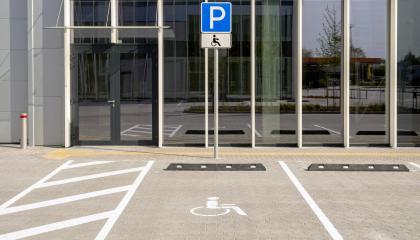
We are committed to accessibility.
Our proprietary, Tactile Walking Surface Indicators (TWSIs) created from nano-tech polymer concrete are the best on the market in terms of compliance, durability, aesthetics, and proven installation. Every tile is fully ADA compliant and meets or exceeds ADAAG, FHWA, California Title 24, state, and local requirements to create accessible urban street design. We back all of our tiles up with a 100% satisfaction guarantee.
StrongGo Industries:
The Designer & Manufacturer of TekWay High-Performance ADA Systems
StrongGo Industries is at the leading edge of Custom Polymer Technologies. A company devoted to the ongoing research, development, and manufacturing of products that have been formulated to possess outstanding physical, chemical, and mechanical properties.
Since 2004, TekWay has been producing reliable ADA Dome Tile solutions to create the perfect balance of functionality, durability, and aesthetics. Through nano-engineering of TekWay ADA products and a proven installation process, StrongGo delivers the best performing ADA system today.
Connect with us
We pride ourselves on our customer service, and we'd love to hear from you! Sign up for our newsletter to keep up with industry updates and trends, as well as any new product releases.

To prepare for current and future Mass Transit projects, designers must select specialized ADA compliant Detectable Warning Surface tiles that will withstand the severe stresses created by high volumes of foot traffic and mobility devices at the platform edge. Tekway High-Performance ADA Tactile Walking Surface Indicator Tiles are a proven system that stay compliant and safe, long after they are installed.

Sidewalks are the lifeline for all pedestrians in any municipality, connecting people from all walks of life to basic necessities and entertainment. Sidewalks last for decades—as should the detectable warning tiles beside them. From dense urban centers to suburban neighborhoods, our detectable warnings will ensure pedestrian safety.

Earning a college degree is a challenge for anyone. Now, add into the equation the need to navigate through the college campus to your classes, whether on foot, bike, scooter, skateboard, or mobility device. Just as tools are needed in every other occupation, Tactile Walking Surface Indicators are used to assist people to travel safely around busy institutions without fear.

Commercial buildings and developments often have unique requirements, from customizable sizes and shapes to different colors of tiles. TekWay can tailor its products to fit any needs, providing lasting durability and aesthetics. Set it and forget it, rather than choosing a product that requires periodic replacing and risks becoming noncompliant and unsafe.

All stadiums and sporting facilities are required to be ADA accessible. TekWay can customize your ADA Tactile Walking Surface Indicators to compliment the surrounding walkways and curb ramps with your favorite home team’s colors. These tactile guidance surfaces will maintain the same level of durability and withstand the expected high pedestrian traffic.

Public accommodations like parks and recreational spaces are designed to be a safe place for enjoying the outdoors. Local and national government officials are required to plan for people with disabilities and to adhere to ADA regulations. Part of the ADA regulations requires the use of detectable warning tiles to be used as a navigational tool for those with low vision.

Airports have constant foot, vehicle, and baggage traffic, and maintaining compliance in such a busy area can be challenging. TekWay ADA systems are the total solution for this type of environment, offering durable longevity and non-slip surfaces that are able to withstand the heavy traffic required.
News & Updates
As organizations adapt their internal policies and culture to reflect evolving understandings of inclusion, it is essential that legal obligations, especially those tied to accessibility, are not diluted in the process. While Diversity, Equity, and Inclusion (DEI) strategies are valuable in fostering awareness and improving representation, they are not a substitute for federally mandated accessibility measures.
Disability does not discriminate. Whether temporary or permanent, visible or invisible, a disability can affect anyone, at any point in life. That is why accessibility must be recognized not as a passing metric, but as a civil right, a public good, and a shared responsibility across every sector of society.
When it comes to accessibility in public spaces, many people know about the Americans with Disabilities Act (ADA), but few understand the network of agencies, guidelines, and technical systems that make the ADA enforceable. These are not DEI initiatives or institutional goals, they are codified legal processes. Here is how the ADA, the U.S. Access Board, and PROWAG work together to ensure public spaces are built for everyone.
Beyond the well-known Americans with Disabilities Act (ADA), there are other critical frameworks and institutions that help guide the development of accessible public spaces in the United States. Chief among them are the U.S. Access Board and the Public Rights-of-Way Accessibility Guidelines (PROWAG). These regulatory tools and institutions are not part of broader DEI frameworks, but rather are foundational to federal civil rights law as it pertains to accessibility.













